Pros: High-quality and great-looking interior; excellent hybrid; strong safety credentials
Cons: Lack of specialty options such as plug-in hybrid and off-road models
Honda's best-selling vehicle is back and bigger than ever in the form of the 2023 Honda CR-V. The compact SUV has been a standard bearer for its segment with a strong blend of good driving dynamics and excellent practicality. That continues for the all-new, sixth-generation model shown here, and thanks to clean new exterior design and a slick interior design, there's an elevated degree of style that's been added to the formula not seen in a CR-V since, well, forever.
As before, the standard turbo engine offers competitive power and fuel economy, but the obligatory CVT sucks the life out of what is otherwise a sweet little Honda engine. The CR-V's hybrid powertrain is new, however, and now exclusively paired with Sport and Sport Touring trim levels to underline that it actually has considerably more power and torque than the gas-only version. It's also much better to drive than both the standard engine and the old hybrid (the simulated shifts make a big difference), and now offers a more efficient front-wheel-drive version. Now, since we're talking powertrains, it's important to note that the CR-V does not offer a plug-in hybrid answer to the Toyota RAV4 Prime, Hyundai Tucson PHEV, Kia Sportage PHEV and Ford Escape PHEV. It's not going to, either, so don't get your hopes up. The most electrified future Honda is going to be the Prologue EV.
Besides the revised hybrid and newfound sense of style, the 2023 Honda CR-V mostly sees a series of incremental improvements everywhere. Its more stable, refined and quiet to drive. The front seats are more comfortable and the back seat seat is a bit more spacious. The infotainment and safety tech have been appreciably upgraded to the point they erase what had been previously cons for the CR-V. It's without question a new-and-improved compact crossover. Could it be even more characterful, including offering sportier or off-road-oriented niche models as rivals do? Sure, as always, the CR-V could be more interesting. But if you're looking for a more conventional small SUV, the new CR-V has to be on your shopping list.
Interior & Technology | Passenger & Cargo Space | Performance & Fuel Economy
What it's like to drive | Pricing & Trim Levels | Crash Ratings & Safety Features
What's new for 2023?
The 2023 Honda CR-V is fully redesigned for the new model year.
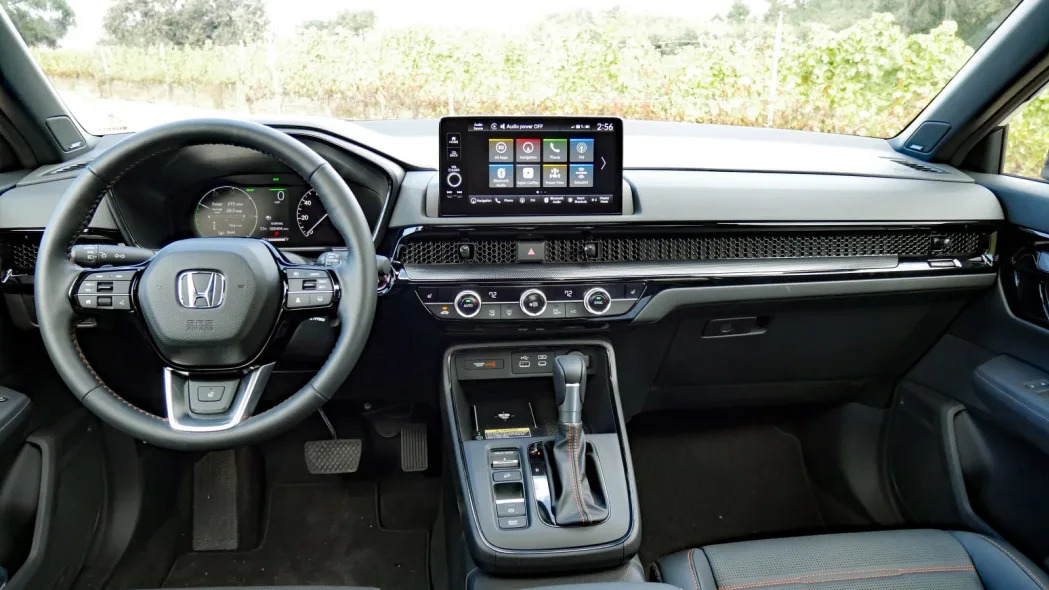
What are the CR-V interior and in-car technology like?
With a whole new exterior comes a whole new interior. Or at least, new to the CR-V. If you've been in a new Civic, its layout and design will look extremely familiar. It's also very similar to the also new HR-V. Fortunately, it's a very good interior. The look is clean and uncomplicated. The dash is also low and in conjunction with relocated front pillars, improves visibility and the sense of spaciousness. All the switchgear feels high-quality with tight, solid action whether it's a turn signal stalk or the highly welcome climate control dials. Though there are many plastics, they have attractive finishes and patterns. It's not quite up to the premium feel of the Mazda CX-50 or CX-5, but it's comparable to Kia Sportage and Hyundai Tucson. It's also much nicer than what you'll find in a Ford Escape or Chevy Equinox.
As for instruments and infotainment, the CR-V features an analog speedometer combined with a 7-inch screen that can display the tachometer and other information. The standard infotainment display is a 7-inch touchscreen (below left) with volume and tuning knobs and a couple of physical menu buttons. Apple CarPlay and Android Auto are standard. On the higher EX-L and Sport Touring trims, the CR-V gets a larger 9-inch touchscreen (below right) with just a volume knob and menu buttons, and both wireless Apple CarPlay and Android Auto plus wireless charging. With either screen size, this infotainment system now uses the operating system and interface from the Accord and other Hondas rather than the slow, buggy and ugly system used by the previous CR-V. It's far more attractive; features large, attractive and easy-to-press icons; there are fewer layers of menus and far faster reactions. It's a system that's actually competitive with its competitors, though we still prefer the Hyundai/Kia system.

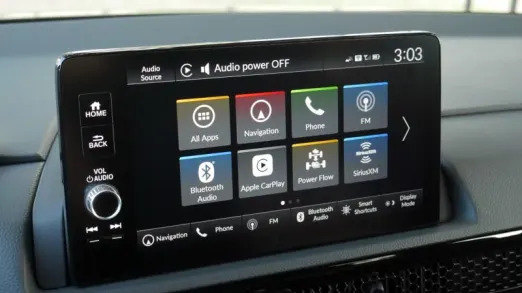
How big is the CR-V?
The CR-V has grown with this generation. It's 2.7 inches longer with a 1.6-inch longer wheelbase, and it's 0.4 inch wider. That also makes it a few inches longer than its key rival, the Toyota RAV4. Ultimately, you're unlikely to notice that much of a difference. There's less than an inch of extra space between the first and second rows, and if anything, an addition 10.5 degrees of back seat recline are the bigger deal. Ditto the more easily accessed car seat LATCH anchors. Basically, the CR-V was one of the biggest and most passenger-friendly compact SUVs around before and continues to be.
Cargo space is now the same regardless of powertrain. The official figure of 36.3 cubic-feet is basically right in between the old hybrid and gas-only volume specs, meaning the new CR-V has both more and less cargo space than before. It also puts it behind the massively enlarged Hyundai Tucson and Kia Sportage, as well as the Toyota RAV4. Our CR-V luggage test backed those on-paper figures: it doesn't have quite as much space as those. Ultimately, though, we're talking degrees of huge here. One important element to note: the CR-V hybrid does not have a spare tire nor underfloor cargo storage. The gas-only version has a spare, as do the Sportage and RAV4 hybrids. The load floor also isn't totally flat when the back seat is folded.
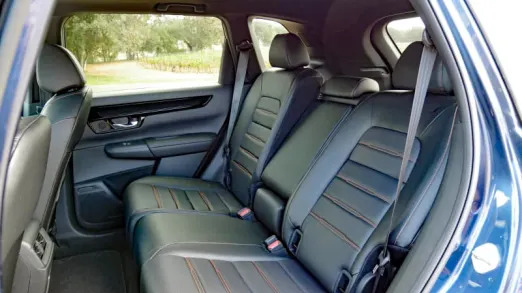
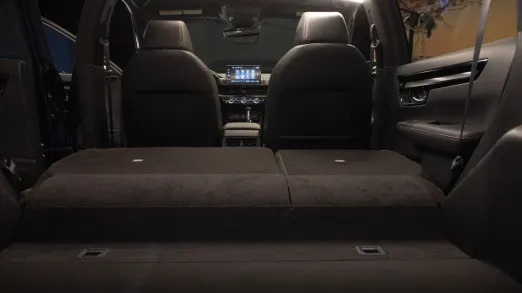
What are the CR-V fuel economy and performance specs?
Two powertrains are available for the 2023 CR-V. As before, the standard turbocharged 1.5-liter four-cylinder makes 190 horsepower and 179 pound-feet of torque. Power goes through a continuously variable transmission and on to either just the front wheels or all four with the optional all-wheel drive. Fuel economy is the same as the previous model. The front-drive version is 28 mpg in the city, 34 on the highway and 30 combined. All-wheel drive brings those numbers down to 27 in the city, 33 on the highway and 29 combined.
The other powertrain is the hybrid. It uses a naturally aspirated 2.0-liter four-cylinder and a pair of electric motors. Under most circumstances, it operates as a series hybrid with the gas engine producing electricity and the larger of the two motors turning the wheels. There are some situations where the gas engine can provide drive power directly. Combined power is 204 horsepower and 247 pound-feet of torque. That's 15 more pound-feet of torque than before, and although it would seem like it has less horsepower, a change in horsepower measurement for 2023 means 2022 and 2023 figures aren't actually comparable. If both used the same measurement, the new CR-V hybrid would have 3 more horsepower. Unlike before, the hybrid can be had with front- or all-wheel drive. The front-drive version bests the old hybrid in fuel economy with 43 mpg in the city, 36 on the highway and 40 combined. The all-wheel-drive version does slightly worse with 40 mpg in the city, 34 on the highway and 37 combined.

What's the CR-V like to drive?
The 2023 is now one of the more engaging compact SUVs to drive, although that's not exactly a high bar and it does depend on which powertrain you get. Perhaps surprisingly, the better performer is the hybrid. The base turbo engine is smooth, but can be noisy, in part due to its CVT that still has some rubber-band characteristics and also makes the powertrain feel somewhat unresponsive. Power is perfectly adequate, but not inspiring. The hybrid, meanwhile, is not only more powerful, but by powering the wheels almost exclusively with its electric motor (the engine is mostly just there to generate electricity), it provides the sort of smooth, effortless power off the line normally associated with EVs. The powertrain also simulates shifts when accelerating, making it sound and feel a lot more normal than other hybrids like the Toyota RAV4 and the CVT-equipped base turbo engine.
Compared to the previous-generation CR-V, the 2023 is notably more refined and stable. Driven back-to-back, it's surprising how much the old CR-V wobbled about with excessive body motions. The new one is far tidier, and results in one of the more composed vehicles in the segment. The steering is also very precise with nice, consistent weighting that allows you to feel the road. Those seeking a sportier feel will still definitely prefer a Mazda CX-5 or CX-50, but in general, Honda has definitely recaptured some of its old driving dynamics mojo with this latest version.
What other Honda CR-V reviews can I read?
2023 Honda CR-V Hybrid First Drive Review
Our most comprehensive look at the new CR-V, with driving impressions of the hybrid along with comparisons to the turbo engine and previous-generation. We also dive deeper into its design and engineering.
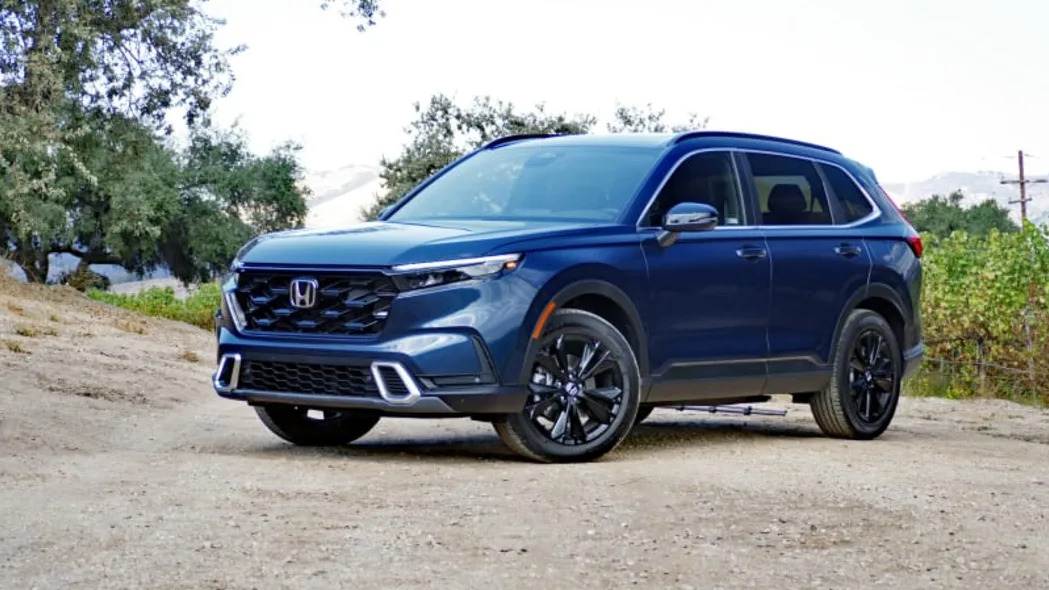
2023 Honda CR-V First Drive Review: Bigger, better, pricier
The CR-V has improved in many ways with a better and more spacious interior. But the competition is starting to leapfrog the CR-V, and with better pricing.
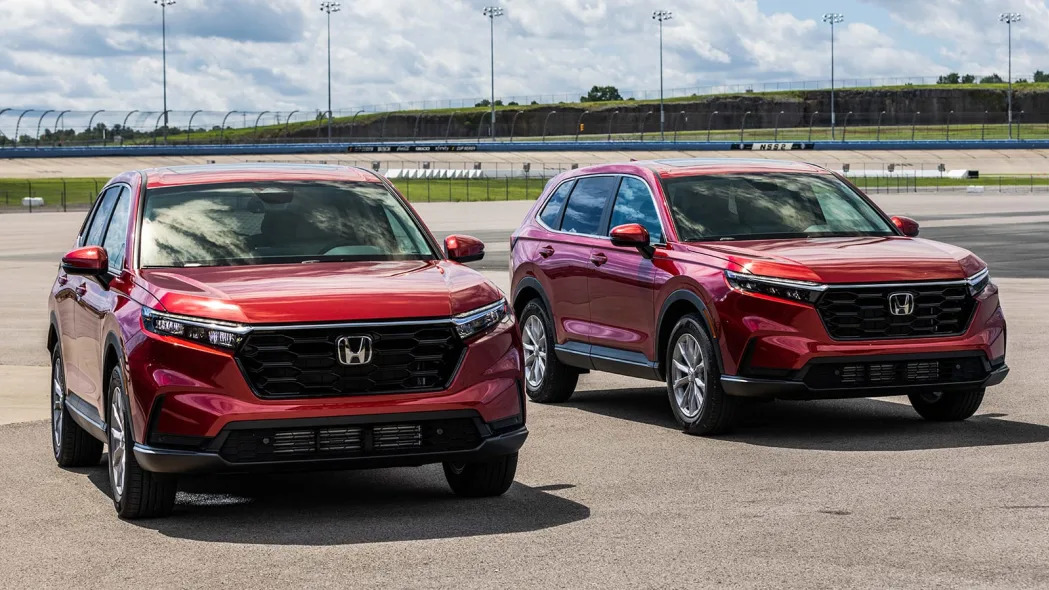
Honda CR-V Luggage Test
We put the CR-V's 36.3 cubic-feet of cargo space to the test with actual suitcases (and a cooler since the space is so darn big)
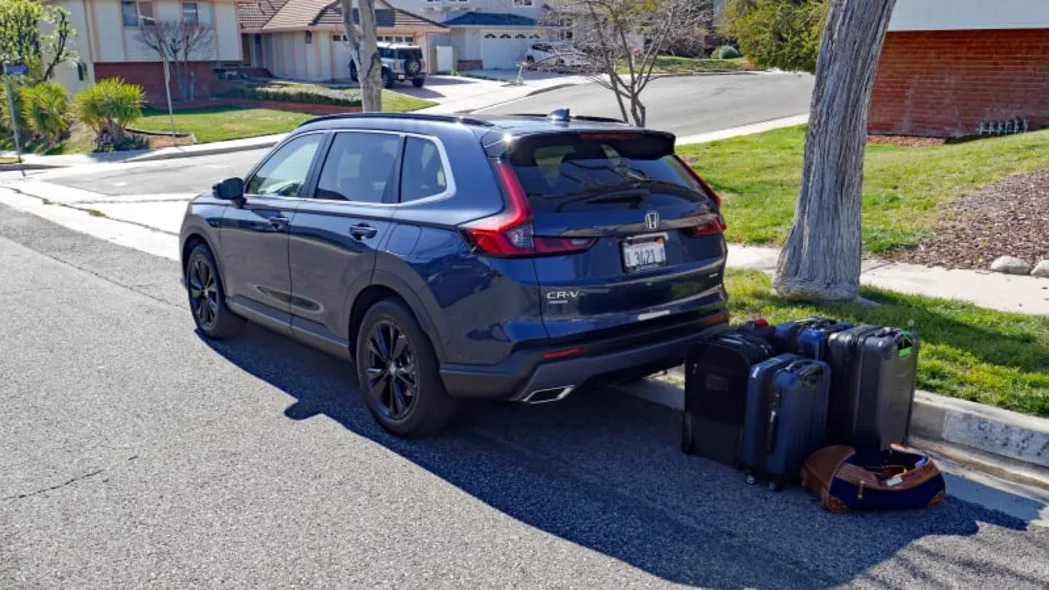
What is the 2023 CR-V price?
The LX trim level was a mid-level addition to the CR-V lineup, so previous complaints about a high starting point no longer apply. All-wheel drive is an extra $1,500 on the EX, EX-L and Sport. Only the Sport Touring trim comes with standard all-wheel drive. Pricing for the line-up is listed below and all include the $1,295 destination charge.
- LX (Turbo): $29,705
- EX (Turbo): $32,355
- Sport (Hybrid): $33,695
- EX-L (Turbo): $35,005
- Sport Touring (Hybrid): $39,845
What are the CR-V safety ratings and driver assistance features?
The 2023 CR-V once again comes with many standard safety and driver assist features. It features forward collision warning, automatic emergency braking, blind-spot and rear cross-traffic warning, lane-keep assist, and adaptive cruise control. These have all been upgraded from the last CR-V, which is good news, as their predecessors were comparatively rudimentary in performance compared to rivals. These ones are much better, but don't quite rise to Hyundai/Kia's systems, particularly in terms of the adaptive cruise control and steering assistance systems.
The Insurance Institute for Highway Safety gave the CR-V the Top Safety Pick+ award for its best-possible performance in all categories, except for one new category: it got two out of three points for front crash prevention at night. So, it's very hard to be safer these days.
Related video:
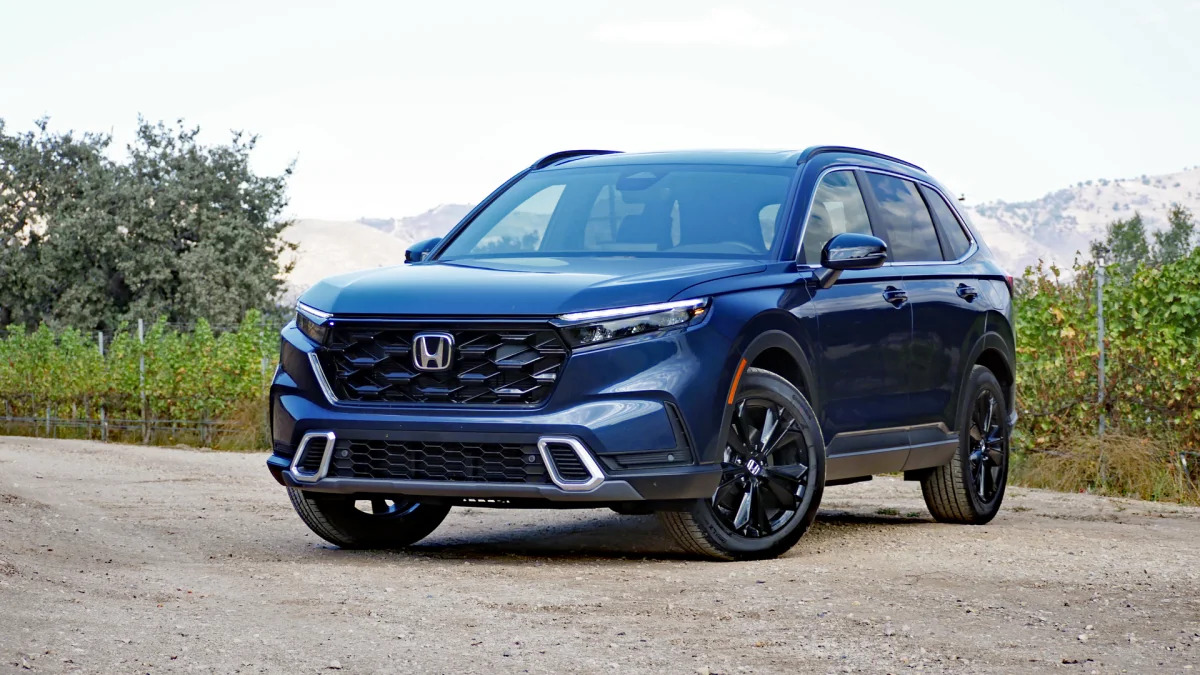











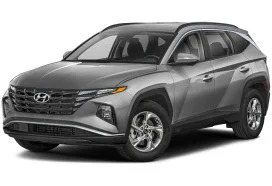

Sign in to post
Please sign in to leave a comment.
Continue